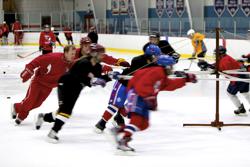19
September
The Season Kick Off!
Posted by Greg Carter

With Labor Day and another summer in the rear view mirror, footballs are air born and preseason NHL games are starting to dot the TV schedule. This could only mean one thing; the youth hockey season is right around the corner.
As players gear up for the season, it’s important to take the time to reflect on what was accomplished during your summer hockey training, and your plans to use the development to be a huge contributor and leader on your team this season.
A good way for players to start this season, is to actually think back to last season.
What areas of your game needed work?
What were the goals that you set for the summer?
Hopefully your summer training allowed you to refocus, work on new skills, get rid of any bad habits and position yourself for a great season.
The areas that you identified as needing work in your post season evaluation were hopefully the key areas of focus for you over the summer. Now is the time to apply everything that you learned, as well as show off those skills that you mastered. Maybe you needed to increase your speed, develop a better shot or improve your stick handling skills. Make sure you take what you learned and apply it to every practice, every game and every shift this season.
Hockey is a game that requires many skills, and putting forth the time and effort in the off season to work hard on your development is part of the equation, but what you do on the ice this season is the true test. Are you prepared to apply your development to your everyday hockey experience?
Everyone has heard the slogan that ‘practice makes perfect’ and this is especially true when it comes to using the tools that you learned over the summer to improvement your skills everyday this season.
Good luck with the start of your season and we look forward to hearing about your next great hockey experience!







 Subscribe
Subscribe Subscribe
Subscribe




